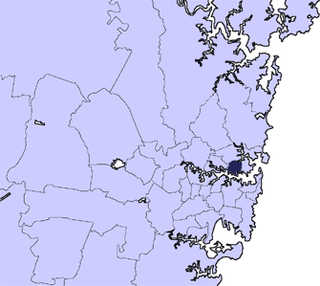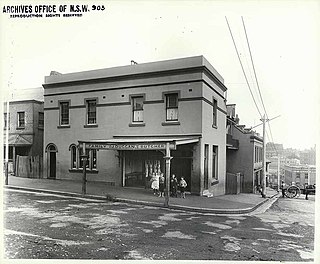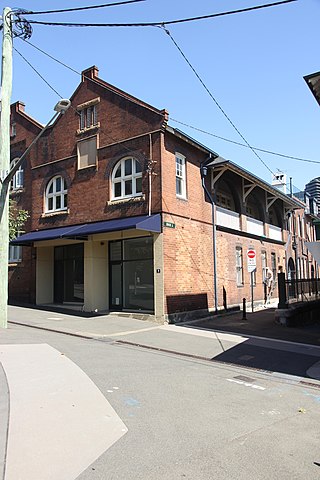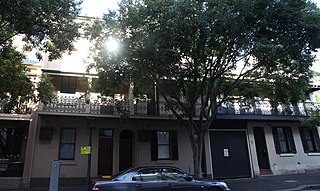
Cremorne is a suburb on the Lower North Shore of Sydney, New South Wales, Australia, located 6 kilometres north-east of the Sydney central business district, in the local government area of North Sydney Council.

North Sydney Council is a local government area on the Lower North Shore of Sydney, New South Wales, Australia, established on 29 July 1890 through the amalgamation of three boroughs.

Bertrand James Waterhouse OBE, FRAIA, FRIBA was an English-born Australian architect and artist.

Cremorne is a heritage-listed villa at 34 Mullens Street, Hamilton, City of Brisbane, Queensland, Australia. It was designed by Eaton & Bates and built from 1905 to 1906. It was added to the Queensland Heritage Register on 21 October 1992.
Henry Austin Wilshire was an architect and prominent member of Sydney society in the late 19th and early 20th centuries. He was an active and innovative architect, and a contributor to the community through interests in town planning and transport issues.

The Bunyas is a heritage-listed residence and former church missionary and scout headquarters at 5 Rogers Avenue, Haberfield, Inner West Council, Sydney, New South Wales, Australia. It was designed by John Spencer-Stansfield and built from 1900 to 1907. It is also known as Stanton Residence. It was added to the New South Wales State Heritage Register on 2 April 1999.

Maitland Lodge of Unity Masonic Hall and Lodge is a heritage-listed masonic lodge and masonic hall at 5 Victoria Street, Maitland, City of Maitland, New South Wales, Australia. It was designed by J. W. Pender and built from 1886 to 1927. The property is owned by Maitland Lodge of Unity. It was added to the New South Wales State Heritage Register on 19 December 2014.

Glen Innes Post and Telegraph Office is a heritage-listed post office at Grey Street, Glen Innes, Glen Innes Severn, New South Wales, Australia. It was designed by NSW Government Architect's Office under Walter Liberty Vernon. and built from 1895 to 1896 by Sandbrook Brothers. The property is owned by Australia Post. It was added to the New South Wales State Heritage Register on 23 June 2000. It was added to the Australian Commonwealth Heritage List on 8 November 2011.

Egglemont is a heritage-listed residence at 11 Cranbrook Avenue, Cremorne, North Sydney Council, New South Wales, Australia. It was built from 1916 to 1918. It is also known as Esslemont. It was added to the New South Wales State Heritage Register on 2 April 1999.

Belvedere is a heritage-listed residence at 7 Cranbrook Avenue, Cremorne, North Sydney Council, New South Wales, Australia. It was designed by Alexander Stewart Jolly. It was added to the New South Wales State Heritage Register on 2 April 1999.

The British Seamen's Hotel is a heritage-listed bar and former hotel, boarding house, office building located at 39–43 Argyle Street, in the inner city Sydney suburb of The Rocks in the City of Sydney local government area of New South Wales, Australia. John Gill built the property in 1886 and is owned by Property NSW, an agency of the Government of New South Wales. It was added to the New South Wales State Heritage Register on 10 May 2002.

Lilyvale is a heritage-listed former town house and now restaurant located at 176 Cumberland Street, in the inner city Sydney suburb of The Rocks in the City of Sydney local government area of New South Wales, Australia. It was built from 1845 to 1847. The property is owned by Property NSW, an agency of the Government of New South Wales. It was added to the New South Wales State Heritage Register on 10 May 2002.

Gannon House is a heritage-listed retail building at 45–47 Argyle Street in the inner-city Sydney suburb of The Rocks in the City of Sydney local government area of New South Wales, Australia. It was designed by Michael Gannon and built from 1839 to 1840 by Michael Gannon as residential houses and stables. It is also known as Michael Gannon's House. As of 2019, it contains a Gannon House Gallery and La Renaissance Patisserie. The property is owned by Property NSW, an agency of the Government of New South Wales. It was added to the New South Wales State Heritage Register on 10 May 2002.

The Butchery Building is a heritage-listed restaurant and former terraced houses and butcher's shop located at 178–180 Cumberland Street, in the inner city Sydney suburb of The Rocks in the City of Sydney local government area of New South Wales, Australia. It was built from 1890 to 1899. It is also known as The Butchery Buildings. The property is owned by Property NSW, an agency of the Government of New South Wales. It was added to the New South Wales State Heritage Register on 10 May 2002.

95-99 George Street, The Rocks are heritage-listed shops and cafe and former dwellings located at 95-99 George Street in the inner city Sydney suburb of The Rocks in the City of Sydney local government area of New South Wales, Australia. It was built from 1868 to 1868. The property is owned by Property NSW, an agency of the Government of New South Wales. It was added to the New South Wales State Heritage Register on 10 May 2002.

182 Cumberland Street, The Rocks is a heritage-listed retail building and residence located at 182 Cumberland Street, in the inner city Sydney suburb of The Rocks in the City of Sydney local government area of New South Wales, Australia. It was designed by Walter Liberty Vernon with the assistance of E. L. Drew and built from 1911 to 1912. The property is owned by Property NSW, an agency of the Government of New South Wales. It was added to the New South Wales State Heritage Register on 10 May 2002.

The Old Coroner's Court, The Rocks are heritage-listed shops and the site of the former The Rocks Visitors Centre, a former morgue, the former Coroner's Court of New South Wales and offices located at 102–104 George Street, in the inner city Sydney suburb of The Rocks in the City of Sydney local government area of New South Wales, Australia. It was designed by Walter Liberty Vernon and built from 1906 to 1908. It is also known as Coroner's Court (former) - Shops & offices, Coroners Court / City Morgue and shops and offices. The property is owned by Property NSW, an agency of the Government of New South Wales. It was added to the New South Wales State Heritage Register on 10 May 2002.

9 Argyle Place is a heritage-listed residence and commercial building at 9 Argyle Place, Millers Point, City of Sydney, New South Wales, Australia. It was built in 1910. It was added to the New South Wales State Heritage Register on 6 June 2003.

90–92 Kent Street, Millers Point are heritage-listed terrace houses located at 90–92 Kent Street, Millers Point, City of Sydney, New South Wales, Australia. The property is owned by Department of Housing. It was added to the New South Wales State Heritage Register on 2 April 1999.

Hinchcliff House is a heritage-listed former wool store, hostel for homeless men and university campus at 5–7 Young Street, Sydney, City of Sydney, New South Wales, Australia. The southern section was built c. 1860, while the northern section was built in the 1880s. It is also known as Hinchcliff's Woolstore, Ozanam House and EF House. It was added to the New South Wales State Heritage Register on 2 April 1999.




















